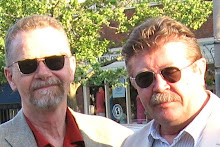THEATRE REVIEW: WHERE THE BLOOD MIXES
12 Apr'10
Blood a little too thin
JOHN COULBOURN - QMI Agency
Rating: 3 out of 5
In a world where the motto "Go big or go home" still holds tremendous sway, director Glynis Leyshon is swimming against the tide, serving up an intimate little production of Kevin Loring's Governor General's Literary Award-winning WHERE THE BLOOD MIXES on the stage of the Factory Theatre.
Of course, this is but the latest stop for a work re-created for the 2010 Cultural Olympiad by the Vancouver Playhouse Company and The Belfry Playhouse Revival Production in association with the Savage Society, returning to Toronto as the centrepiece of Factory's annual Performance Spring Festival after a brief visit during Luminato a few years back.
Set in a First Nation's settlement at the confluence of the Fraser and the Thompson Rivers, it tells the story of three survivors of the notorious residential school programme, and of the lingering scars they carry from the infamous abuse.
It is the story of Floyd, a one-time railway worker played by Billy Merasty, and of his drinking companion, the aptly-named Mooch, a one-time lumberjack, played by Ben Cardinal. While both men have led productive lives, these days, their principal occupation seems to be the occasional fishing trip, interspersed with prolonged benders in the local watering whole, run by their buddy George — essayed with Cheers-like charm and wisdom by Tom McBeath.
While Floyd relies a lot on credit and on George's goodwill to keep the booze flowing, Mooch relies instead on an uncanny ability to cadge from others that has earned him his nickname. When that fails, however, he is not above stealing grocery money from his sweetheart, June (Margo Kane), a habit that has earned him more than a few slaps up along side the head from the outraged June. Both men dream of winning the big prize in George's ongoing pull-tab lottery.
Suddenly, their boozy routine is interrupted when Floyd receives a letter from his long lost daughter (Kim Harvey), taken from him by the authorities as a small child, shortly after the death of her mother.
Raised by a loving family in Vancouver, she is now a grown woman, and she's hoping for a reunion — a reunion, that when it comes, strips away all the scars that have built up in her three elders over the years, exposing wounds that are still raw and festering, offering in the process a chance for healing to begin.
Simply sketched by the playwright, this is nonetheless a moving tale, or at least it could have been, if Leyshon and her cast had opted to go deep when they eschewed the whole notion of going big.
Although set designer Robert Lewis conspires with lighting designer Itai Erdal and projection designer Jamie Nesbitt to create a wonderfully adaptable dreamscape on which the tale can play out, Leyshon allows her cast to simply skate over the surface of the first half of the tale, switching gears so rapidly for the second half that it all but tears the transmission out of what drives the play. While she is clearly trying to sidestep the worst cliches of aboriginal people and alcohol abuse, Leyshon ultimately fails to appreciate that by making the effects of abuse entertaining, she diminishes not just those effects, but the abuse as well.
Despite wonderful contributions from musician Jason Burnstick and visual artist Carl Stromquist, this is one artistic fusion that doesn't qualify so much as a dramedy as simply a strange beast with a sitcom head and a tragic tail, and though the simple heart of it beats strongly WHERE THE BLOOD MIXES, the rest of it is just sort of dead in the water.
Monday, April 12, 2010
Subscribe to:
Post Comments (Atom)




No comments:
Post a Comment